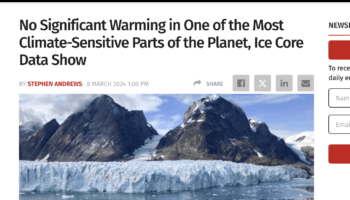- Climate
Claim that cosmic rays are a crucial player for current climate change is unsupported
Key takeaway
It is clear from many lines of evidence that human activities—not solar activity—are responsible for modern climate change.
Reviewed content

Verdict:
Claim:
Based on the increase of solar activity during the twentieth century, it should account for between half to two-thirds of all climate change
Verdict detail
Misleading: Evidence shows that solar activity can explain very little of the observed warming since the Industrial Revolution.
Inadequate support: The claim that cosmic rays are a "crucial player" for the climate is not representative of published research on the topic.
Full Claim
'Based on the increase of solar activity during the twentieth century, it should account for between half to two-thirds of all climate change'[...] Both Galactic and Solar Cosmic rays hitting Earth’s atmosphere create aerosols which, in turn, seed clouds (Svensmark et al) — making them a crucial player in earth’s weather and climate.
The article mentions cosmic rays, claiming that changes in cosmic ray nucleation of clouds (via solar activity) can explain most of modern global warming. The effect of cosmic rays has been studied extensively1,2, leading to the conclusion that cosmic rays have not correlated with global cloud cover or temperature. Pierce and Adams conclude that:
“changes in cloud condensation nuclei from changes in cosmic rays during a solar cycle are two orders of magnitude too small to account for the observed changes in cloud properties; consequently, we conclude that the hypothesized effect is too small to play a significant role in current climate change”1,
While Agee et al conclude:
“the observational results presented, showing several years of disconnect between Galactic Cosmic Rays and lower-troposphere global cloudiness, add additional concern to the cosmic ray–cloud connection hypothesis.”
An experiment at CERN that directly tested the ability of cosmic rays to nucleate cloud droplets found that “variations in cosmic ray intensity do not appreciably affect climate through nucleation in the present-day atmosphere.”3
The 2013 IPCC report summarized research on this topic when it stated, “Cosmic rays enhance new particle formation in the free troposphere, but the effect on the concentration of cloud condensation nuclei is too weak to have any detectable climatic influence during a solar cycle or over the last century.”4
The scientists’ comments below explain that besides this cosmic ray hypothesis, the solar radiative forcing fluctuations are also insufficient to explain climate changes over the past decades—in contrast to the radiative forcing due to the increased greenhouse gases released by human activities, which matches the magnitude of the observed warming.
- 1- Pierce and Adams (2009) Can cosmic rays affect cloud condensation nuclei by altering new particle formation rates?, Geophysical Research Letters
- 2- Agee et al (2011) Relationship of Lower-Troposphere Cloud Cover and Cosmic Rays: An Updated Perspective, Journal of Climate
- 3- Dunne et al (2016) Global atmospheric particle formation from CERN CLOUD measurements, Science
- 4- IPCC (2013) Chapter 7, Climate Change 2013: The Physical Science Basis

Assistant Professor, San Jose State University
[This comment comes from a previous review of a similar claim.]
Careful analysis that attempts to take into account all major factors and their evolution in time indicates that anthropogenic increases in greenhouse gasses account for more than 100% of the observed warming on the century timescale (requiring cancellation from cooling influences). See the summary graphic from Carbon Brief, below.


Postdoctoral Research fellow, U.S. Geological Survey
[This comment comes from a previous review of a similar claim.]
Solar forcing is much smaller than CO2 forcing. As this figure from the latest IPCC report shows, CO2 radiative forcing (1.68 W/m2) dwarfs solar forcing (0.05 W/m2). Along with other greenhouse gases, CO2 dominates the total radiative forcing when all positive and negative factors are taken into account.
Figure – Radiative forcing estimates in 2011 relative to 1750. Values are global average radiative forcing, partitioned according to the emitted compounds or processes that result in a combination of drivers. Source IPCC AR5

Professor, University of East Anglia, and Director of Research, Climatic Research Unit
[This comment comes from a previous review of a similar claim.]
There is strong evidence that solar forcing cannot explain much of the observed warming at all. The “fingerprint” of solar forcing does not match the observed changes at all, neither over time nor space. Solar forcing would warm both the stratosphere and the surface of the Earth, whereas CO2 warms the surface (and the troposphere) but cools the stratosphere. Using radiosondes and (more recently) satellites, we have observed a warming surface and troposphere together with a cooling stratosphere. See Santer et al (2013)* for one of many studies providing this evidence.
 Figure – Zonal-mean atmospheric temperature trends in satellite observations from January 1979 to December 2012 showing warming of the lower atmosphere (troposphere) and cooling of the upper-atmosphere (stratosphere), from Santer et al (2013)*
Figure – Zonal-mean atmospheric temperature trends in satellite observations from January 1979 to December 2012 showing warming of the lower atmosphere (troposphere) and cooling of the upper-atmosphere (stratosphere), from Santer et al (2013)*
- Santer et al (2013) Human and natural influences on the changing thermal structure of the atmosphere, PNAS




